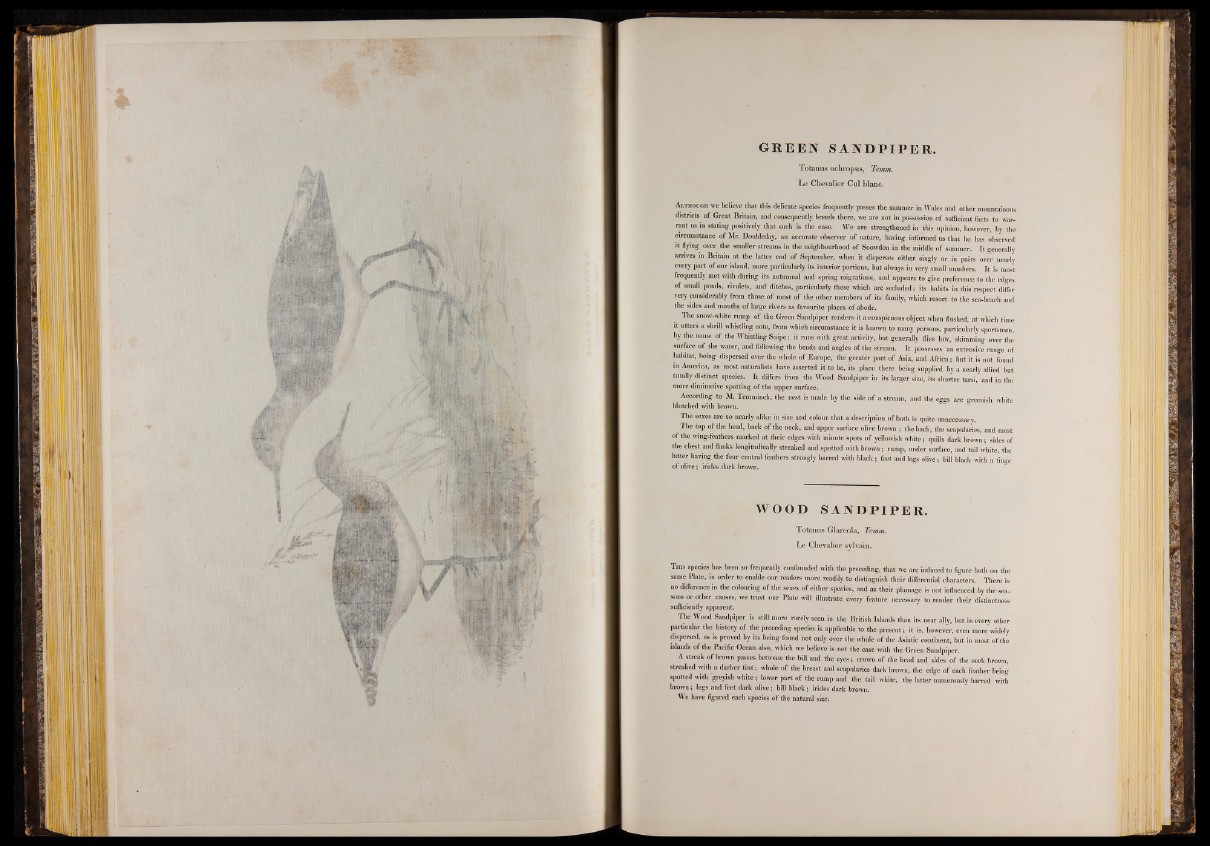
GREEN SANDPI P E R .
T o tan u s och rop us, Temm.
L e C h e va lie r C u l blanc.
A l t h o u g h we believe that this delicate species frequently passes the summer in Wales and other mountainous
districts o f Great Britain, and coqsequently breeds there, we are not in possession o f sufficient facts to warrant
us in stating positively that such is the case. We are strengthened in this opinion, however, by the
circumstance o f Mr. Doubleday, an accurate observer o f nature, having informed us that he has observed
it flying over the smaller streams in the neighbourhood o f Snowdon in the middle o f summer. It generally
arrives in Britain at the latter end o f September, when it disperses either singly or in pairs over nearly
every part o f our island, more particularly its interior portions, but always in very small numbers. It is most
frequently met with during its autumnal and spring migrations, and appears to give preference to the edges
o f small ponds, rivulets, and ditches, particularly those which are secluded: its habits in this respect differ
very considerably from those o f most o f the other members o f its family, which resort to the sea-beach and
the sides and mouths o f large rivers as favourite places o f abode.
The snow-white rump o f the Green Sandpiper renders it a conspicuous object when flushed, at which time
it utters a shrill whistling note, from which circumstance it is known to many persons, particularly sportsmen,
by the name o f the Whistling Snipe: it runs with great activity, but generally flies low, skimming over the
surface o f the water, and following the bends and angles o f the stream. It possesses an extensive range o f
habitat, being dispersed over the whole o f Europe, the greater part o f Asia, and Africa; but it is not found
in America, as most naturalists have asserted it to be, its place there being supplied by a nearly allied but
totally distinct species. It differs from the Wood Sandpiper in its larger size, its shorter tarsi, and in the
more diminutive spotting o f the upper surface.
According to M. Temminck, the nest is made by the side of a stream, and the eggs are greenish white
blotched with brown.
The sexes are so nearly alike in size and colour that a description o f both is quite unnecessary.
The top o f the head, back o f the neck, and upper surface olive brown ; the back, the scapularies, and most
o f the wing-feathers marked at their edges with minute spots o f yellowish white; quills dark brown; sides of
the chest and flanks longitudinally streaked and spotted with brown; rump, under surface, and tail white, the
latter having the four central feathers strongly barred with black; feet and legs olive; bill black with a tinge
o f olive; irides dark brown.
WOOD SANDP I PE R .
To tan us G 1 areola, Temm.
L e C h e va lie r sy lv ain .
T his species has been so frequently confounded with the preceding, that we are induced to figure both on the
same Plate, in order to enable our readers more readily to distinguish their differential characters. There is
no difference in the colouring o f the sexes o f either species, and as their plumage is not influenced by the sea-
sons or other causes, we trust our Plate will illustrate every feature necessary to render their distinctness
sufficiently apparent.
The Wood Sandpiper is still more rarely seen in the British Islands than its near ally, bnt in every other
particular the history o f the preceding species is applicable to the present; it is, however, even more widely
dispersed, as is proved by its being found not only over the whole o f the Asiatic continent, but in most o f the
islands o f the Pacific Ocean also, which we believe is not the case with the Green Sandpiper,
A streak o f brown passes between the bill and the eyes; crown o f the head and sides o f the neck brown,
streaked with a darker tint; whole o f the breast and scapularies dark brown, the edge of each feather being
spotted with ’greyish white; lower part o f the rump and the tail white, the latter numerously barred with
brown; legs and feet dark olive; bill black; irides dark brown.
We have figured each species o f the natural size.